Abstract
The accumulation of dicarboxylic acids, particularly long chain, is a prominent feature of Reye's syndrome and diseases of peroxisomal metabolism. We assessed the omega-oxidation of a spectrum of fatty acids in rats and asked whether pretreatment of rats with aspirin, which is known to predispose children to Reye's syndrome, would affect omega-oxidation of long chain fatty acids. We found that aspirin increased liver free fatty acids and increased the capacity for omega-oxidation three- to sevenfold. Omega-oxidation of long chain substrate was stimulated to a greater degree than medium chain substrate and was apparent within one day of treatment, at serum aspirin concentrations below the therapeutic range in humans. The apparent Km for lauric acid was 0.9 microM and 12 microM for palmitate. We also found a difference in the storage stability of activity toward medium and long chain substrate. Saturating concentrations of palmitate had no effect on the formation of dodecanedioic acid, whereas laurate decreased but never eliminated the omega-oxidation of palmitate. 97% of the total laurate omega-oxidative activity recovered was found in the microsomes, but 32% of palmitate omega-oxidative activity was present in the cytosol. These results demonstrate that aspirin is a potent stimulator of omega-oxidation and suggest that there may be multiple enzymes for omega-oxidation with overlapping substrate specificity.
Full text
PDF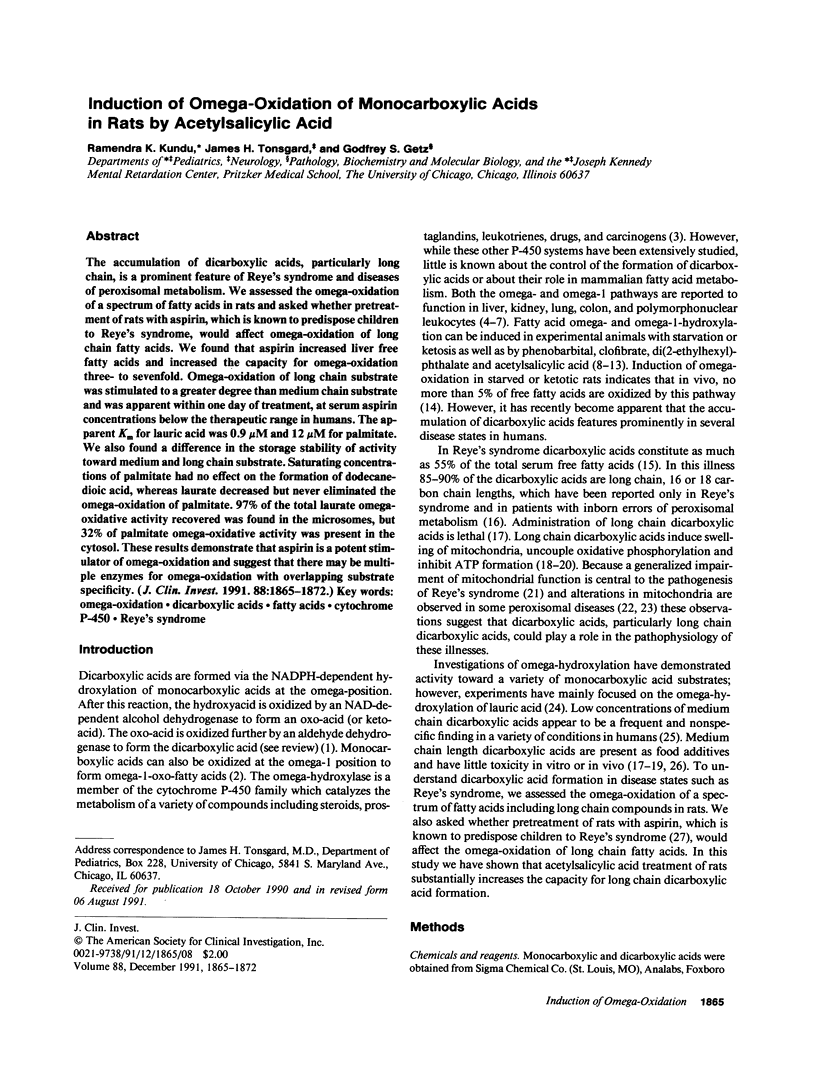

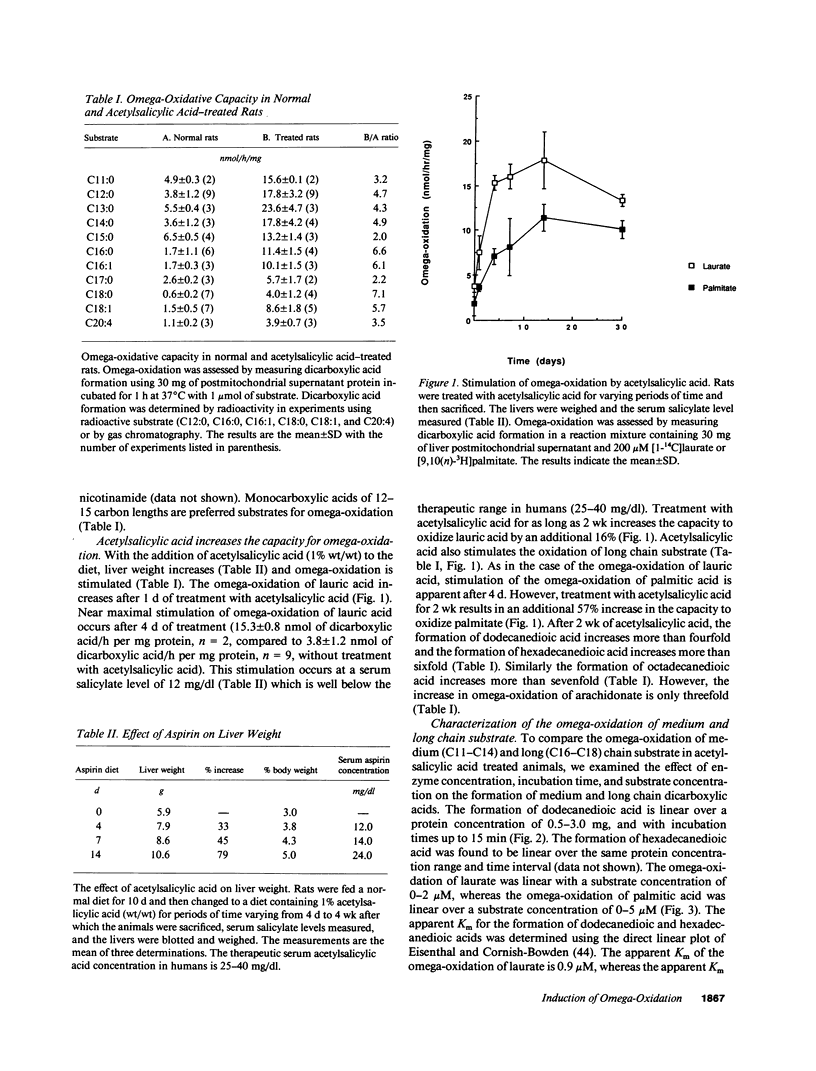
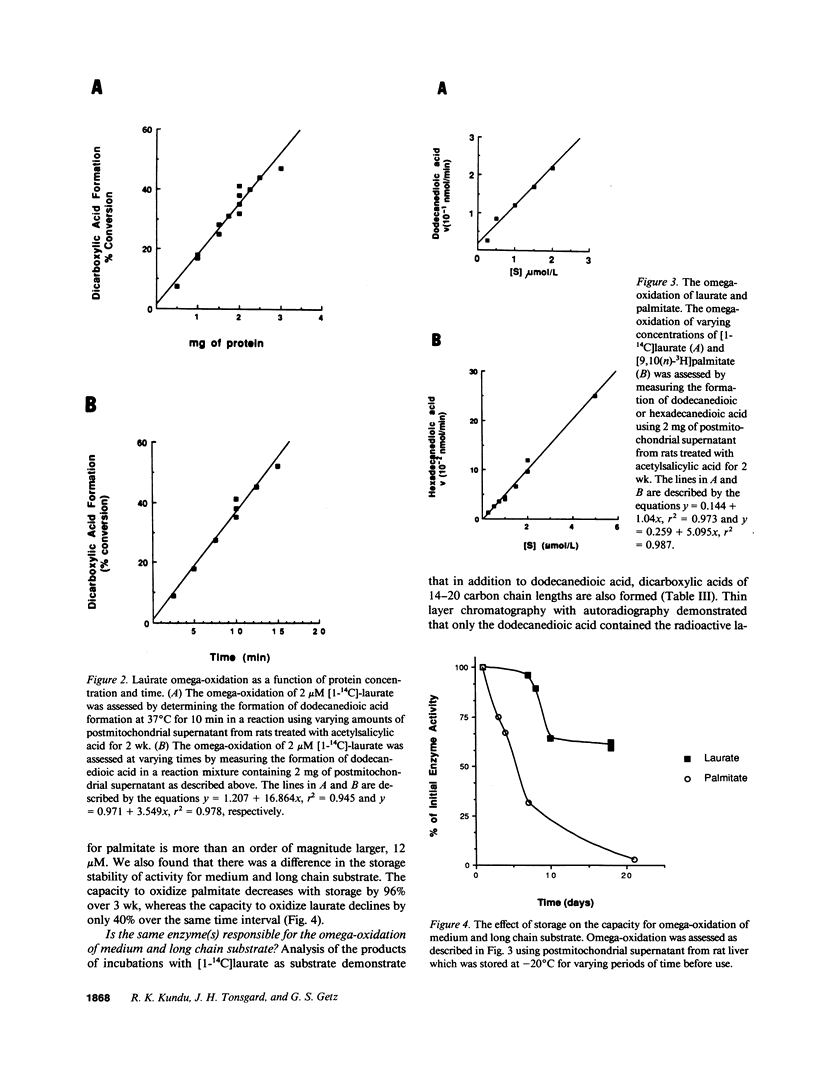

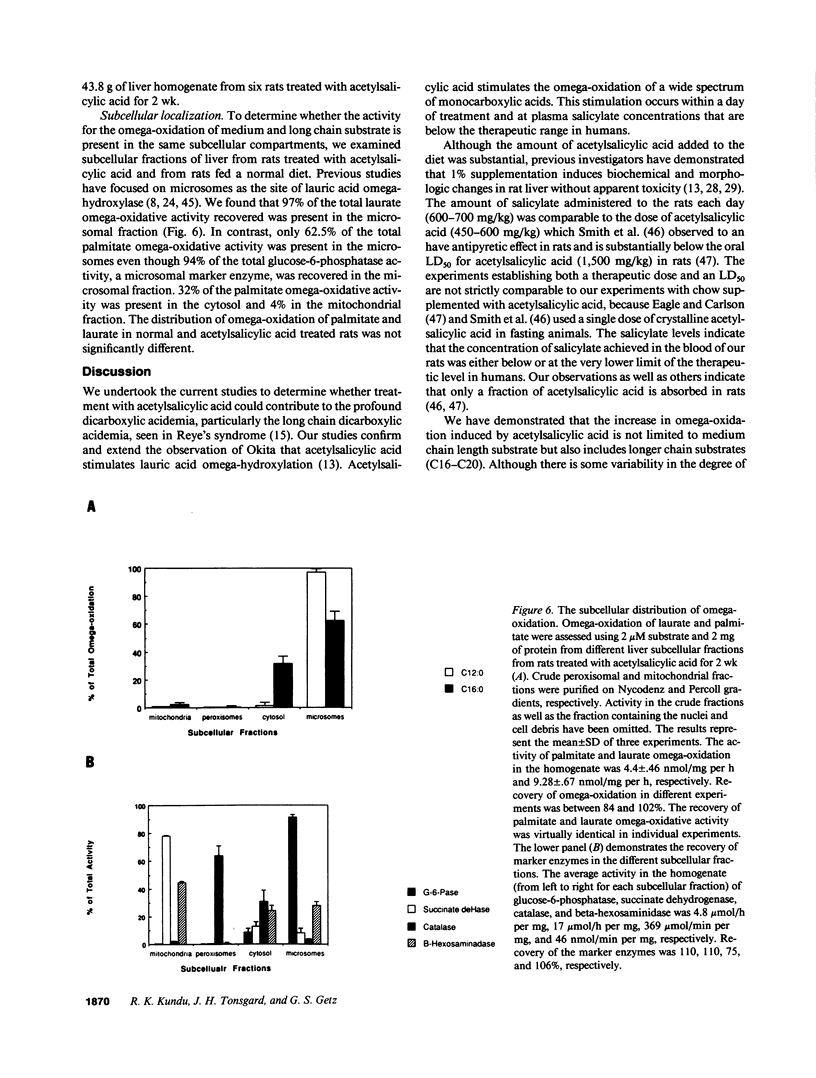
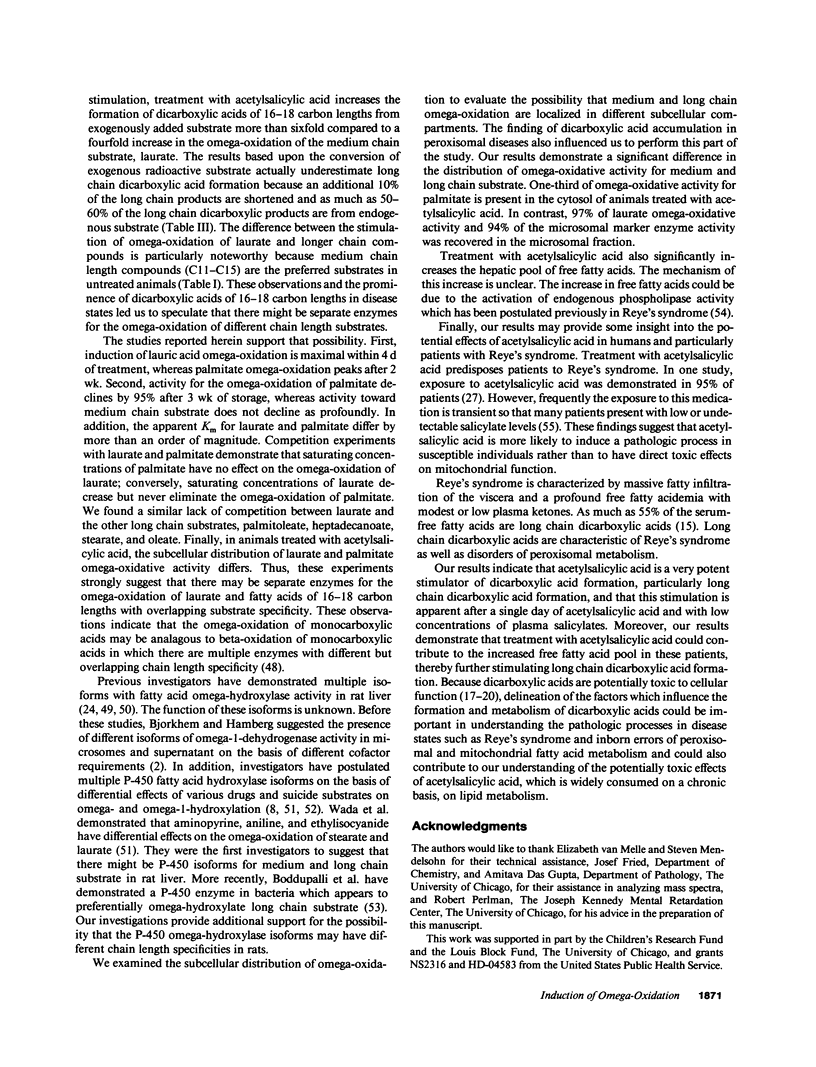

Selected References
These references are in PubMed. This may not be the complete list of references from this article.
- Björkhem I. Microsomal dehydrogenation of omega1- and omega2-hydroxy fatty acids. Biochim Biophys Acta. 1972 Feb 21;260(2):178–184. [PubMed] [Google Scholar]
- Björkhem I. Omega-oxidation of stearic acid in the normal, starved and diabetic rat liver. Eur J Biochem. 1973 Dec 17;40(2):415–422. doi: 10.1111/j.1432-1033.1973.tb03210.x. [DOI] [PubMed] [Google Scholar]
- Björkhem I. On the quantitative importance of omega-oxidation of fatty acids. J Lipid Res. 1978 Jul;19(5):585–590. [PubMed] [Google Scholar]
- Boddupalli S. S., Estabrook R. W., Peterson J. A. Fatty acid monooxygenation by cytochrome P-450BM-3. J Biol Chem. 1990 Mar 15;265(8):4233–4239. [PubMed] [Google Scholar]
- Capdevila J., Kim Y. R., Martin-Wixtrom C., Falck J. R., Manna S., Estabrook R. W. Influence of a fibric acid type of hypolipidemic agent on the oxidative metabolism of arachidonic acid by liver microsomal cytochrome P-450. Arch Biochem Biophys. 1985 Nov 15;243(1):8–19. doi: 10.1016/0003-9861(85)90768-4. [DOI] [PubMed] [Google Scholar]
- Clancy R. M., Dahinden C. A., Hugli T. E. Oxidation of leukotrienes at the omega end: demonstration of a receptor for the 20-hydroxy derivative of leukotriene B4 on human neutrophils and implications for the analysis of leukotriene receptors. Proc Natl Acad Sci U S A. 1984 Sep;81(18):5729–5733. doi: 10.1073/pnas.81.18.5729. [DOI] [PMC free article] [PubMed] [Google Scholar]
- Cohen G., Dembiec D., Marcus J. Measurement of catalase activity in tissue extracts. Anal Biochem. 1970 Mar;34:30–38. doi: 10.1016/0003-2697(70)90083-7. [DOI] [PubMed] [Google Scholar]
- DE DUVE C., PRESSMAN B. C., GIANETTO R., WATTIAUX R., APPELMANS F. Tissue fractionation studies. 6. Intracellular distribution patterns of enzymes in rat-liver tissue. Biochem J. 1955 Aug;60(4):604–617. doi: 10.1042/bj0600604. [DOI] [PMC free article] [PubMed] [Google Scholar]
- EAGLE E., CARLSON A. J. Toxicity, antipyretic and analgesic studies on 39 compounds including aspirin, phenacetin and 27 derivatives of carbazole and tetrahydrocarbazole. J Pharmacol Exp Ther. 1950 Aug;99(41):450–457. [PubMed] [Google Scholar]
- FOLCH J., LEES M., SLOANE STANLEY G. H. A simple method for the isolation and purification of total lipides from animal tissues. J Biol Chem. 1957 May;226(1):497–509. [PubMed] [Google Scholar]
- Ghosh M. K., Hajra A. K. A rapid method for the isolation of peroxisomes from rat liver. Anal Biochem. 1986 Nov 15;159(1):169–174. doi: 10.1016/0003-2697(86)90323-4. [DOI] [PubMed] [Google Scholar]
- Gibson G. G., Orton T. C., Tamburini P. P. Cytochrome P-450 induction by clofibrate. Purification and properties of a hepatic cytochrome P-450 relatively specific for the 12- and 11-hydroxylation of dodecanoic acid (lauric acid). Biochem J. 1982 Apr 1;203(1):161–168. doi: 10.1042/bj2030161. [DOI] [PMC free article] [PubMed] [Google Scholar]
- Goldfischer S., Moore C. L., Johnson A. B., Spiro A. J., Valsamis M. P., Wisniewski H. K., Ritch R. H., Norton W. T., Rapin I., Gartner L. M. Peroxisomal and mitochondrial defects in the cerebro-hepato-renal syndrome. Science. 1973 Oct 5;182(4107):62–64. doi: 10.1126/science.182.4107.62. [DOI] [PubMed] [Google Scholar]
- Hamberg M., Björkhem I. -Oxidation of fatty acids. I. Mechanism of microsomal 1- and 2-hydroxylation. J Biol Chem. 1971 Dec 25;246(24):7411–7416. [PubMed] [Google Scholar]
- Hardwick J. P., Song B. J., Huberman E., Gonzalez F. J. Isolation, complementary DNA sequence, and regulation of rat hepatic lauric acid omega-hydroxylase (cytochrome P-450LA omega). Identification of a new cytochrome P-450 gene family. J Biol Chem. 1987 Jan 15;262(2):801–810. [PubMed] [Google Scholar]
- Hruban Z., Mochizuki Y., Goto M., Slesers A., Chou S. H. Effects of some hypocholesterolemic agents on hepatic ulrastructure and microbody enzymes. Lab Invest. 1974 Apr;30(4):474–485. [PubMed] [Google Scholar]
- Hruban Z., Swift H., Slesers A. Ultrastructural alterations of hepatic microbodies. Lab Invest. 1966 Dec;15(12):1884–1901. [PubMed] [Google Scholar]
- Hurwitz E. S., Barrett M. J., Bregman D., Gunn W. J., Schonberger L. B., Fairweather W. R., Drage J. S., LaMontagne J. R., Kaslow R. A., Burlington D. B. Public Health Service study on Reye's syndrome and medications. Report of the pilot phase. N Engl J Med. 1985 Oct 3;313(14):849–857. doi: 10.1056/NEJM198510033131403. [DOI] [PubMed] [Google Scholar]
- Ikeda Y., Dabrowski C., Tanaka K. Separation and properties of five distinct acyl-CoA dehydrogenases from rat liver mitochondria. Identification of a new 2-methyl branched chain acyl-CoA dehydrogenase. J Biol Chem. 1983 Jan 25;258(2):1066–1076. [PubMed] [Google Scholar]
- Kelley R. I. Review: the cerebrohepatorenal syndrome of Zellweger, morphologic and metabolic aspects. Am J Med Genet. 1983 Dec;16(4):503–517. doi: 10.1002/ajmg.1320160409. [DOI] [PubMed] [Google Scholar]
- Kimura S., Hanioka N., Matsunaga E., Gonzalez F. J. The rat clofibrate-inducible CYP4A gene subfamily. I. Complete intron and exon sequence of the CYP4A1 and CYP4A2 genes, unique exon organization, and identification of a conserved 19-bp upstream element. DNA. 1989 Sep;8(7):503–516. doi: 10.1089/dna.1.1989.8.503. [DOI] [PubMed] [Google Scholar]
- Kolodny E. H., Mumford R. A. Human leukocyte acid hydrolases: characterization of eleven lysosomal enzymes and study of reaction conditions for their automated analysis. Clin Chim Acta. 1976 Jul 15;70(2):247–257. doi: 10.1016/0009-8981(76)90426-5. [DOI] [PubMed] [Google Scholar]
- Kupfer D. Endogenous substrates of monooxygenases: fatty acids and prostaglandins. Pharmacol Ther. 1980;11(3):469–496. doi: 10.1016/0163-7258(80)90038-8. [DOI] [PubMed] [Google Scholar]
- LOWRY O. H., ROSEBROUGH N. J., FARR A. L., RANDALL R. J. Protein measurement with the Folin phenol reagent. J Biol Chem. 1951 Nov;193(1):265–275. [PubMed] [Google Scholar]
- MITZ M. A., HEINRIKSON R. L. Omega hydroxy fatty acid dehydrogenase. Biochim Biophys Acta. 1961 Jan 1;46:45–50. doi: 10.1016/0006-3002(61)90644-8. [DOI] [PubMed] [Google Scholar]
- Mays D. C., Sharp D. E., Beach C. A., Kershaw R. A., Bianchine J. R., Gerber N. Improved method for the determination of aspirin and its metabolites in biological fluids by high-performance liquid chromatography: applications to human and animal studies. J Chromatogr. 1984 Nov 28;311(2):301–309. doi: 10.1016/s0378-4347(00)84723-4. [DOI] [PubMed] [Google Scholar]
- Mortensen P. B. Dicarboxylic acids and the lipid metabolism. Dan Med Bull. 1984 Apr;31(2):121–145. [PubMed] [Google Scholar]
- Mortensen P. B., Gregersen N. The biological origin of ketotic dicarboxylic aciduria. II. In vivo and in vitro investigations of the beta-oxidation of C8-C16-dicarboxylic acids in unstarved, starved and diabetic rats. Biochim Biophys Acta. 1982 Mar 12;710(3):477–484. doi: 10.1016/0005-2760(82)90132-1. [DOI] [PubMed] [Google Scholar]
- NOVAK M. COLORIMETRIC ULTRAMICRO METHOD FOR THE DETERMINATION OF FREE FATTY ACIDS. J Lipid Res. 1965 Jul;6:431–433. [PubMed] [Google Scholar]
- Nebert D. W., Gonzalez F. J. P450 genes: structure, evolution, and regulation. Annu Rev Biochem. 1987;56:945–993. doi: 10.1146/annurev.bi.56.070187.004501. [DOI] [PubMed] [Google Scholar]
- Newton J. F., Eckardt R., Bender P. E., Leonard T., Straub K. Metabolism of leukotriene B4 in hepatic microsomes. Biochem Biophys Res Commun. 1985 Apr 30;128(2):733–738. doi: 10.1016/0006-291x(85)90108-1. [DOI] [PubMed] [Google Scholar]
- Okita R. T., Masters B. S. Effect of phenobarbital treatment and cytochrome P-450 inhibitors on the laurate omega- and (omega - 1)-hydroxylase activities of rat liver microsomes. Drug Metab Dispos. 1980 May-Jun;8(3):147–151. [PubMed] [Google Scholar]
- Okita R., Chance C. Induction of laurate omega-hydroxylase by di (2-ethylhexyl)phthalate in rat liver microsomes. Biochem Biophys Res Commun. 1984 May 31;121(1):304–309. doi: 10.1016/0006-291x(84)90723-x. [DOI] [PubMed] [Google Scholar]
- Okita R. Effect of acetylsalicylic acid on fatty acid omega-hydroxylation in rat liver. Pediatr Res. 1986 Dec;20(12):1221–1224. doi: 10.1203/00006450-198612000-00003. [DOI] [PubMed] [Google Scholar]
- Ortiz de Montellano P. R., Reich N. O. Specific inactivation of hepatic fatty acid hydroxylases by acetylenic fatty acids. J Biol Chem. 1984 Apr 10;259(7):4136–4141. [PubMed] [Google Scholar]
- PENNINGTON R. J. Biochemistry of dystrophic muscle. Mitochondrial succinate-tetrazolium reductase and adenosine triphosphatase. Biochem J. 1961 Sep;80:649–654. doi: 10.1042/bj0800649. [DOI] [PMC free article] [PubMed] [Google Scholar]
- PREISS B., BLOCH K. OMEGA-OXIDATION OF LONG CHAIN FATTY ACIDS IN RAT LIVER. J Biol Chem. 1964 Jan;239:85–88. [PubMed] [Google Scholar]
- Passi S., Nazzaro-Porro M., Picardo M., Mingrone G., Fasella P. Metabolism of straight saturated medium chain length (C9 to C12) dicarboxylic acids. J Lipid Res. 1983 Sep;24(9):1140–1147. [PubMed] [Google Scholar]
- Passi S., Picardo M., Nazzaro-Porro M., Breathnach A., Confaloni A. M., Serlupi-Crescenzi G. Antimitochondrial effect of saturated medium chain length (C8-C13) dicarboxylic acids. Biochem Pharmacol. 1984 Jan 1;33(1):103–108. doi: 10.1016/0006-2952(84)90376-9. [DOI] [PubMed] [Google Scholar]
- Pettersen J. E., Jellum E., Eldjarn L. The occurrence of adipic and suberic acid in urine from ketotic patients. Clin Chim Acta. 1972 Apr;38(1):17–24. doi: 10.1016/0009-8981(72)90202-1. [DOI] [PubMed] [Google Scholar]
- RICKETTS T. R. An improved micromethod for the determination of glucose-6-phosphatase activity. Clin Chim Acta. 1963 Jan;8:160–162. doi: 10.1016/0009-8981(63)90218-3. [DOI] [PubMed] [Google Scholar]
- Rocchiccioli F., Aubourg P., Bougnères P. F. Medium- and long-chain dicarboxylic aciduria in patients with Zellweger syndrome and neonatal adrenoleukodystrophy. Pediatr Res. 1986 Jan;20(1):62–66. doi: 10.1203/00006450-198601000-00018. [DOI] [PubMed] [Google Scholar]
- Schwarz K. B., Larroya S., Kohlman L., Morrison A. Erythrocyte lipid abnormalities in Reye's syndrome. Pediatr Res. 1987 Apr;21(4):352–356. doi: 10.1203/00006450-198704000-00006. [DOI] [PubMed] [Google Scholar]
- Shak S., Reich N. O., Goldstein I. M., Ortiz de Montellano P. R. Leukotriene B4 omega-hydroxylase in human polymorphonuclear leukocytes. Suicidal inactivation by acetylenic fatty acids. J Biol Chem. 1985 Oct 25;260(24):13023–13028. [PubMed] [Google Scholar]
- Tamburini P. P., Masson H. A., Bains S. K., Makowski R. J., Morris B., Gibson G. G. Multiple forms of hepatic cytochrome P-450. Purification, characterisation and comparison of a novel clofibrate-induced isozyme with other major forms of cytochrome P-450. Eur J Biochem. 1984 Mar 1;139(2):235–246. doi: 10.1111/j.1432-1033.1984.tb07999.x. [DOI] [PubMed] [Google Scholar]
- Tonsgard J. H., Getz G. S. Effect of Reye's syndrome serum on isolated chinchilla liver mitochondria. J Clin Invest. 1985 Aug;76(2):816–825. doi: 10.1172/JCI112039. [DOI] [PMC free article] [PubMed] [Google Scholar]
- Tonsgard J. H., Huttenlocher P. R. Salicylates and Reye's syndrome. Pediatrics. 1981 Nov;68(5):747–748. [PubMed] [Google Scholar]
- Tonsgard J. H. Serum dicarboxylic acids in patients with Reye syndrome. J Pediatr. 1986 Sep;109(3):440–445. doi: 10.1016/s0022-3476(86)80114-7. [DOI] [PubMed] [Google Scholar]
- WAKABAYASHI K., SHIMAZONO N. Studies on omega-oxidation of fatty acids in vitro. I. Overall reaction and intermediate. Biochim Biophys Acta. 1963 Apr 23;70:132–142. doi: 10.1016/0006-3002(63)90733-9. [DOI] [PubMed] [Google Scholar]
- Wada F., Shibata H., Goto M., Sakamoto Y. Participation of the microsomal electron transport system involving cytochrome P-450 in omega-oxidation of fatty acids. Biochim Biophys Acta. 1968 Nov 26;162(4):518–524. doi: 10.1016/0005-2728(68)90058-3. [DOI] [PubMed] [Google Scholar]


